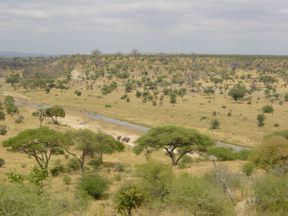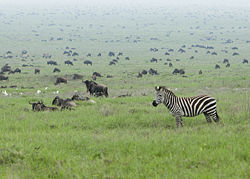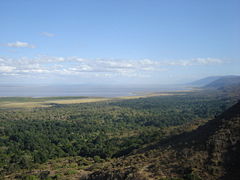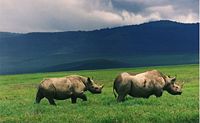

























Inquiries:
fay@faysafaris.com
 +447700094142 +447700094142
 +255784334511 +255784334511
|
|
|
Arusha National Park

Arusha National Park lies on a 300-kilometre axis of Africa's
most famous national parks, running from Serengeti and Ngorongoro Crater in the
west to Kilimanjaro National Park in the east.
The park is just a few kilometers north east of Arusha, though the main gate is
25 km east of the city. It is also 58 km from Moshi and 35 km from Kilimanjaro
International Airport (KIA).
Arusha National Park has a rich variety of wildlife. Despite
the small size of the park, common animals include giraffe, buffalo, zebra,
warthog, the black-and-white colobus monkey, the blue monkey, flamingos and more.
|
-
Tarangire National Park

Tarangire National Park is probably one of the least visited of the northern
Tanzanian game parks, and retains a real air of undiscovered Africa,
particularly in the south of the park. Just a two hours drive away from Arusha,
the park is a nice stop if time does not allow for a visit to Serengeti and
Ngorongoro.
It lies a little distance to the south east of Lake Manyara and covers an area
of approximately 2,850 square kilometers. It is named after the Tarangire River
that flows through the park.
|
|
Serengeti National Park

The
Serengeti is a 60,000 square kilometer savanna which lies over Tanzania.[1] The
biannual migration that occurs there is considered one of the seven tourist
travel wonders of the world. The region contains several national parks and game
reserves. Serengeti is derived from the Maasai language, Maa; specifically "Serengit",
meaning "Endless Plains".
The Serengeti has more than 2 million herbivores and thousands of predators.
Blue Wildebeests, gazelles, zebras and buffalos are the animals most commonly
found in the region.
The Serengeti hosts the largest and longest overland migration in the world,[4]
a biannual occurrence. Around October, nearly 2 million herbivores travel from
the northern hills toward the southern plains, crossing the Mara River, in
pursuit of the rains. In April, they then return to the north through the west,
once again crossing the Mara river. This phenomenon is sometimes called the
Circular Migration. Over 250,000 wildebeest alone will die along the journey
from Tanzania to Maasai Mara reserves in upper Kenya, a total of 500 miles.
Death is often caused by injury, exhaustion, or predation.
The park covers 14,763km≤ of grassland plains and savanna as well as riverine
forest and woodlands. The park lies in the north of the country, bordered to the
north by the national Tanzania and Kenyan border, where it is contiguous with
the Masai Mara National Reserve. To the south-east of the park is Ngorongoro
Conservation Area, to the south-west lies Maswa Game Reserve, and to the western
borders are Ikorongo and Grumeti Game Reserves, finally to the north-east lies
Loliondo Game Control Area.
|
Manyara National Park

Lake Manyara is a shallow fresh-water lake in Tanzania. Said
by Ernest Hemingway to be the "loveliest [lake] ... in Africa," it is also the
home of a diverse set of landscapes and wildlife.
The name "Manyara" comes from the Masai word emanyara, which is a euphorbia
species of plant that is grown into a hedge around a family homestead.
Of the 127 square miles (329 km≤) of Lake Manyara National Park, the lake's
alkaline waters cover approximately 89 square miles (231 km≤). While most known
for baboons, the lake and its environs is also home to herbivores such as
hippos, impalas, elephants, wildebeests, buffalo, warthogs and giraffes. Giant
fig trees and mahogany seen in the groundwater forest immediately around the
park gates draw nourishment from the underground springs replenished
continuously from crater highlands directly above the Manyara basin. Leading
away from the forest to the fringes of Lake Manyara are the flood plains. To the
south are visible the acacia woodlands. Leopards, although in abundance, are
hard to get a glimpse of, just like the other elusive carnivores - the lions -
of this park.
Lake Manyara provides opportunities for ornithologists keen on viewing and
observing over 300 migratory birds, including flamingo, long-crested eagle and
grey-headed kingfisher.
With an entrance gate that doubles as an exit, the trail of Lake Manyara
National Park is effectively a loop that can be traversed by jeep within a
couple of hours that may be stretched to a few more at best, if driving slowly,
to watch, observe and enjoy the diversity of flora and fauna. The Rift Valley
escarpment forms a noteworthy landmark and provides a spectacular backdrop to
Lake Manyara.
|
-
-
Ngorongoro
Conservation Area

The Ngorongoro
Conservation Area or NCA is a conservation area situated 180 km west of Arusha
in the Crater Highlands area of Tanzania. The conservation area is administered
by the Ngorongoro Conservation Area Authority, an arm of the Tanzanian
government, and its boundaries follow the boundary of the Ngorongoro Division of
Ngorongoro District. It is 8,288 km≤ - about the size of Crete. A
population of about 25,000 large animals, largely ungulates along with
(reputedly) the highest density of mammalian predators in Africa, lives in the
crater. These include black rhinoceros, which have declined from about 108 in
1964-66 to between 11-14 in 1995, and hippopotamus which are very uncommon in
the area. There are also many other ungulates: wildebeest (7,000 estimated in
1994), zebra (4,000), eland, Grantís and Thomsonís gazelles (3,000).The crater
has the densest known population of lion numbering 62 in 2001. On the crater rim
are leopard, elephant numbering 42 in 1987 but only 29 in 1992, mountain
reedbuck and buffalo (4,000 in 1994).

Wildlife at Ngorongoro Crater.
However, since the 1980s the craterís wildebeest population has fallen by a
quarter to about 19,000 and the numbers of eland and Thomsonís gazelle have also
declined while buffalos increased greatly, probably due to the long prevention
of fire which favors high fibrous grasses over shorter less fibrous types. In
summer enormous numbers of Serengeti migrants pass through the plains of the
reserve, including 1.7 million wildebeest, 260,000 zebra and 470,000 gazelles.
Waterbuck mainly occur mainly near Lerai Forest; servals occur widely in the
crater and on the plains to the west. Common in the reserve are lion,
hartebeest, spotted hyena and jackal. Cheetah, though common in the reserve, are
scarce in the crater itself. Wild dog has recently disappeared from the crater
and may have declined elsewhere in the Conservation Area as well.

The main feature of the NCA is the Ngorongoro Crater, which is the world's
largest unbroken, unflooded volcanic caldera. The Crater, which formed as the
giant volcano exploded and collapsed on itself some two to three million years
ago, is 610m deep and the floor is 260km≤ (102 square miles). [5]
Although thought of as "a natural enclosure" for a very wide variety of
wildlife, up to 20% or more of the wildebeest and half the zebra populations
vacate the Crater in the wet season. Animal populations in the crater include
most of the species found in East Africa, but there are no impalas, topis ,
giraffes , or crocodiles.
|



